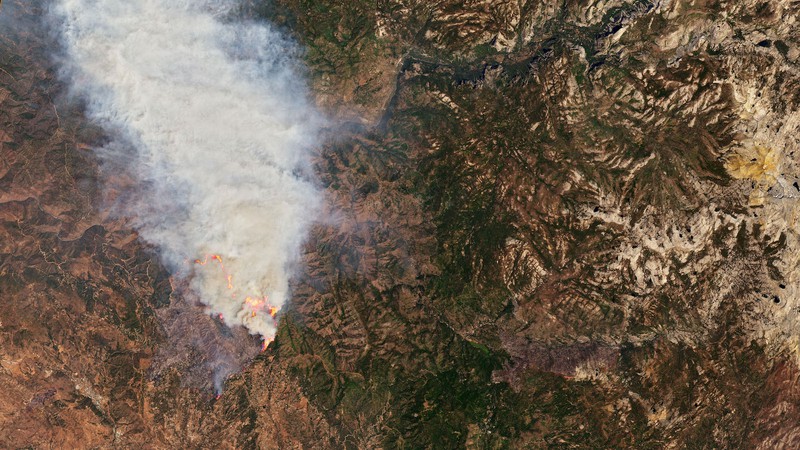The largest California fire of 2022 exploded due to extreme climate conditions.

The explosive Oak Fire in Mariposa County, as seen in a satellite image from space. NASA Earth Observatory Public Domain
The California drought is getting worse and that’s one of the reasons the Oak Fire in Mariposa County, near Yosemite National Park, took less than three days to become California’s largest wildfire of 2022. After igniting on Friday, July 22—due to causes that remained undetermined—the fire had burned 6,500 acres by Saturday morning.
By Tuesday, Gov. Gavin Newsom declared a state of emergency as the flames had consumed 18,087 acres, according to a Cal Fire incident report, along with 41 buildings. Though more than 3,000 people were evacuated, no injuries had been reported four days into the wildfire, which by Tuesday was listed as 26 percent contained by Cal Fire.
“Contained,” it should be noted, is not the same as “extinguished.” A fire is described as “contained” when firefighters have established a boundary wide enough to prevent heat or embers from escaping the area. But fire within a containment zone retains at least the potential to jump that line, especially if conditions change.
The Oak Fire started while firefighters were still battling the Washburn Fire, also in Mariposa County near Yosemite. While the cause of that fire remained under investigation, officials believed it was sparked by some sort of human activity. In its early hours, Cal Fire described the activity of the Oak Fire as “extreme.”
The Oak Fire and Climate Change
Why has the Oak Fire burned so quickly and explosively? The answer can be traced, of course, to the increasingly severe conditions attributable to climate change. According to research published in the journal Nature, drought conditions in the southwest region of what is now the United States from 2000 to 2021 were the worst they’d been in 12 centuries. The last known drought worse than the one that has gripped the region for the last two decades occurred in the late 16th century.
High heat also fuels fires, and an extreme heat wave is partly responsible for the rapid expansion of the Oak Fire. The fire also struck at a time when not just California but, in fact, the world was in the clutches of a record-breaking hot spell. According to National Weather Service meteorologist Felix Castro, the region of California where the fires were burning had endured 13 straight days of temperatures in the triple-digit range with humidity below 10 percent.
Regions in the southwest and northeastern United States have seen heat records fall in recent days, as has Europe, where wildfires have burned in both France and Spain. The Chinese Meteorological Association said that 31 cities in the world’s most populous country were under heat warnings.
How Does Climate Change Trigger Heat Waves?
While the entire planet is warming at a rate that has been the fastest in recorded history since 1981, the Arctic region is heating up three to four times faster than the rest of the globe. That creates a situation in which temperatures up north come closer to those at the equator than they normally would, or should. According to Arctic climate expert Jennifer Francis of Woodwell Climate Research Center in Massachusetts, the result is a wild swing in the North Atlantic jet stream, which sets off extreme weather events, including heat waves.
In addition, the simple fact that the Earth’s atmosphere is hotter means that heat waves will also be hotter.
"Every heat wave that we are experiencing today has been made hotter and more frequent because of climate change," Friederike Otto, climate scientist at Imperial College London, told the news agency Reuters.
Increased heat causes vegetation to dry out more quickly. Dryness levels in vegetation—what fire experts call “fuel moisture levels,” because dried-out plant life is fuel for wildfires—are currently four months ahead of schedule, according to fire officials cited by the Los Angeles Times. In other words, vegetation at the end of June was already as dry as it would be by the end of October in a normal year.
Dryness creates more fuel, and that causes fires to spread more rapidly and with greater force—which seems to be exactly what happened in the early stages of the Oak Fire.
How Destructive Will the Oak Fire Get?
Whether firefighters will be able to bring the Oak Fire under control remains an open question, as of July 27. While the fire took only three days to become the state’s largest of 2022, it still has some ways to go before it matches the biggest fire in California history.
The August Complex Fire, which was a combination of several smaller fires that merged into one gargantuan blaze, burned more than one million acres in seven counties—Mendocino, Humboldt, Trinity, Tehama, Glenn, Lake, and Colusa. That was only two years ago, in August 2020.
The second-largest fire in state history came 11 months later. The Dixie Fire ripped through Butte, Plumas, Lassen, Shasta, and Tehama, burning more than 960,000 acres in July 2021.